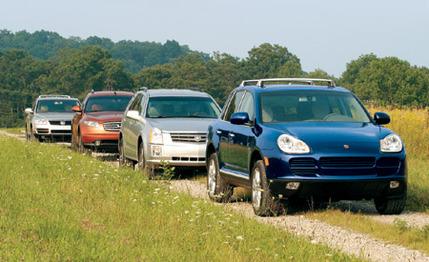
 Comparison Tests
Comparison Tests
It is true we were in Ohio immediately preceding the Great Blackout of '03, in which, tragically, the milk of perhaps millions of Americans went badly sour.
But we categorically deny that we had anything to do with causing it. Perhaps it was caused by faulty transmission lines—no one had claimed responsibility by the time we went to print. It is also possible the failure was sparked by a lightning bolt from above after He found out about the "Cornhole Tournament" taking place at a bar in downtown Athens. The Supreme Court might be more permissive than in years past about what goes on behind closed doors, or in the saloons of an Ohio college town, but we're not sure it's all sitting well with the ghostwriter of the Good Book.
The do-gooders would say the root cause is that every single American just cranks up the A/C and leaves every TV and light on in the house, all the while running a small industrial concern in the basement. Maybe they're right. Maybe we all are overpowered and overpampered. But does the Do-Gooder and Hand Wringer home office not have air conditioning?
The purpose of our little road trip was to get to the heart of this matter and test the relative merits of the hottest niche within a segment of the ever-burgeoning sport-utility class: sporty, on-road-oriented SUVs designed primarily for an American audience that is overendowed with power (the ante to get into this game was 300 horsepower) and bursting with every imaginable device for pampering its well-heeled occupants but offering no more room for cargo than a routine-sized station wagon.
All told, we had 1280 horsepower split fairly evenly among the four V-8 engines that power the Cadillac SRX (320 hp), the Infiniti FX45 (315), the Porsche Cayenne S (335), and the Volkswagen Touareg (310). With the equivalent of 954 kilowatts of electric power pumping from these pumped-up utes, we could have powered a sizable neighborhood. Until we ran out of gas, which, in a group that averages 15 mpg, wouldn't take long. But, you know, screw that! It's our power, after all, and we're going to use all of it as often as we want. We would crank the air-conditioning units to full chill, play with the navigation systems, adjust our power seats, raise power-adjustable suspensions for no reason at all, and still sprint to 60 mph in an average of seven seconds just because we could. You wouldn't have?
We would not go off-road, though, because, well, why would we? Sure, all these vehicles have all-wheel drive, but even the kid at an Athens plant store recognized them as "a buncha fancy wagons." The Cadillac and the Infiniti are based on sports sedans (the CTS and the G35, respectively), not pickup trucks. The Porsche and the VW, which were designed together and share many parts, do have low-range gearing (just like a Jeep CJ7!) and air bladders that will raise their bodies until they look really silly. These add cost and weight (you can order either vehicle without the air suspension), which is unfortunate for the Germans. Also, both came with high-performance street tires with shallow tread that would have hobbled even a Hummer, off-road, anyway. Besides, off-roading is so uncomfortable.
Perhaps by now you've noticed the absence of one key competitor, the BMW X5. It was the X5 that first carved this little performance niche out of the lumbering masses of utility. There are a few reasons for its absence. The X5 has competed in two comparison tests and failed to win either—most recently, a VW Touareg surpassed it. The X5's V-8 is 10 shy of the requisite 300 horses. And soon—but not yet—it will have 325 horsepower. For 2004, the X5 gets the six-speed automatic and higher-hp, 4.4-liter V-8 from the 7-series, along with a new all-wheel-drive system. But we could not obtain a test vehicle so outfitted, and running an old one so shortly before substantial improvements would be helpful to no one.
Other V-8 utes such as the Lexus GX470 and Buick Rainier have either scored low in a previous comparo or are lacking the sporting gene. And the V-6—powered utes? They're out. This is not about merely adequate power, modesty, or reason.